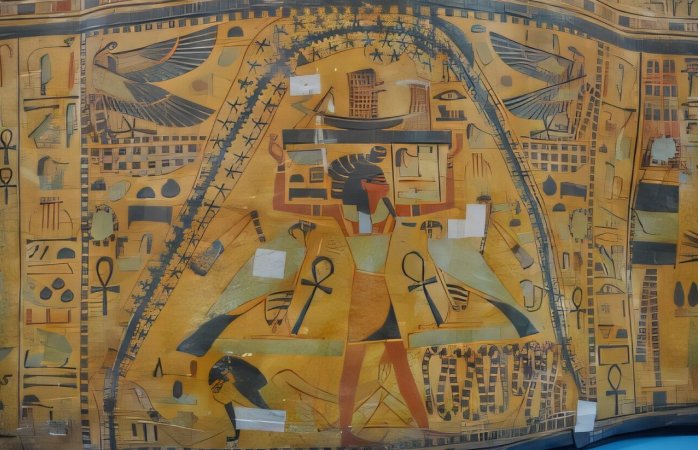Conny Waters – AncientPages.com – Ancient Egyptians held a deep fascination with celestial objects, and recent research provides new insights into how they perceived the Milky Way. This study sheds light on how these early astronomers observed and interpreted this prominent feature of the night sky, offering a glimpse into their understanding of the cosmos.

Nut’s cosmological vignette on the outer coffin of Nesitaudjatakhet in the collection of Odessa Archaeological Museum OAM 52976 (C107). Nut’s body is covered in stars as well as a thick, undulating black curve that runs from the soles of her feet to the tips of her fingers. This curve, surrounded by stars on both sides, is reminiscent of the Milky Way’s Great Rift. Credit: Mykola Tarasenko; Odessa Archaeological Museum, NASU
Dr. Or Graur, an Associate Professor of Astrophysics at the University of Portsmouth, has been exploring the intriguing connection between the Milky Way and ancient Egyptian culture and religion. He believes he may have discovered what could be an ancient Egyptian visual representation of the Milky Way. In his research, Dr. Graur examined 125 images of Nut, the sky-goddess, from 555 ancient Egyptian coffins dating back nearly 5,000 years to determine if she might be associated with the Milky Way.
Nut is often depicted as a naked woman arched over her brother Geb, symbolizing her role as a protector of Earth from cosmic chaos and her involvement in the solar cycle—swallowing the sun at dusk and birthing it at dawn. Typically adorned with stars or solar disks in scenes depicting day and night skies, Nut’s posture signifies her connection to both celestial phenomena and her role in providing earthly protection.
However, on Nesitaudjatakhet’s coffin—a chantress of Amun-Re who lived around 3,000 years ago—Nut is portrayed differently. An unusual black curve crosses her body from feet to fingertips with stars evenly distributed above and below this line. This unique depiction suggests a possible connection between Nut’s imagery and the appearance of our galaxy in ancient times.
“I think that the undulating curve represents the Milky Way and could be a representation of the Great Rift—the dark band of dust that cuts through the Milky Way’s bright band of diffused light. Comparing this depiction with a photograph of the Milky Way shows the stark similarity,” Dr. Graur said.

The Milky Way over the sand dunes of the Egyptian Western Desert near El-Fayoum, taken on 5–7 August 2022 at 12:00 AM (total exposure: 1.2 hours). Note the similarity between the Great Rift and the undulating black curve that bisects Nut’s body. Credit: Osama Fathi
He added, “Similar undulating curves appear in four tombs in the Valley of the Kings. In the tomb of Ramesses VI, for example, the ceiling of the burial chamber is split between the Book of the Day and the Book of the Night. Both include arched figures of Nut displayed back-to-back and separated by thick, golden undulating curves that issue from the base of Nut’s head and travel above her back all the way to her rear.”
“I did not see a similar undulating curve in any of the other cosmological representations of Nut and it is my view that the rarity of this curve reinforces the conclusion I reached in a study of ancient texts last year, which is that although there is a connection between Nut and the Milky Way, the two are not one and the same. Nut is not a representation of the Milky Way. Instead, the Milky Way, along with the sun and the stars, is one more celestial phenomenon that can decorate Nut’s body in her role as the sky.”
In a study published in April 2024, Dr. Graur utilized an extensive array of ancient sources, including the Pyramid Texts, Coffin Texts, and the Book of Nut. By comparing these with advanced simulations of the Egyptian night sky, he argued that the Milky Way may have emphasized Nut’s significance as the sky goddess in Egyptian mythology.
The research suggested that during winter, the Milky Way illuminated Nut’s outstretched arms, while in summer it outlined her backbone across the sky. Since the initial publication, Dr. Graur’s conclusions regarding Nut and her connection to the Milky Way have continued to evolve and develop.
“The texts, on their own, suggested one way to think about the link between Nut and the Milky Way. Analyzing her visual depictions on coffins and tomb murals added a new dimension that, quite literally, painted a different picture,” Dr. Graur said.

The astronomical ceiling from the tomb of Seti I (KV 17). Note the undulating black curves between rows of yellow half-circles that border the two halves of the ceiling. Credit: Theban Mapping Project, Francis Dzikowski, May 2000
Both the current and previous studies are integral components of a broader project led by Dr. Graur, aimed at cataloging and examining the multi-cultural mythology associated with the Milky Way. Dr. Graur explained that his interest was sparked while writing a book on galaxies, during which he encountered the sky-goddess Nut in relation to Milky Way mythology. His curiosity deepened following a museum visit with his daughters, who were captivated by an image of an arched woman and eagerly requested stories about her.
The study was published in the Journal of Astronomical History and Heritage
Written by Conny Waters – AncientPages.com Staff Writer









